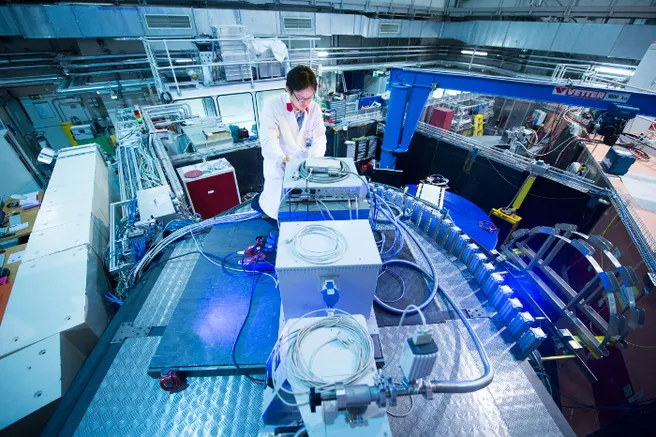Transporting electricity without losses is the promise of superconducting materials. Iron-based superconductors are a complete mystery for researchers: As iron is actually a magnetic material, which should prevent the superconductivity. Considering the electrons as tiny compass needles, all are in parallel in the magnetized iron. However, for conventional superconductivity, the electrons must be coupled antiparallel with spherical symmetry (phase preserved order) for the formation of the superconducting Cooper pairs. This seems to be different with iron-based superconductors. Therefore, they are also named "unconventional superconductors”.
Scattered neutrons off from an unconventional superconductor often carry the information about the structure of the superconducting electron pair (Cooper pair). Here, researchers always observed in the iron-containing superconductors a peculiar excitation of spins briefly below the transition temperature at which the material becomes superconducting. This so-called magnetic resonant mode indicates a phase reversed alignment of the electron compass needles, supporting that the spin excitations are a sort of "glue" for the Cooper pairs.
With the collaboration of TUM scientist Dr. Jitae Park on three-axes spectrometer PUMA, however, the two scientific teams from Japan and China led by Dr. Chul-ho Lee at Advanced Industrial Science and Technology and Porf. Jun Zhao at Fudan University observed a transition from phase-reversed to phase-preserved Cooper pair formation. This reversal of the signs obviously depends on the degree of doping of the iron-selenide and iron-arsenide superconductors under investigation: If the superconductor had more than 50% sulfur in the iron-selenides and 80% of potassium in the iron-arsenides added, the mode suddenly disappears, indicating that the electron pairs changed back to phase-preserved symmetry.
"Our findings suggest that the iron-based superconductors are much more complicated than previously thought," says Dr. Jitae Park. Further measurements with neutrons are therefore already planned.
Original publications:
Suppression of spin-exciton state in hole overdoped iron-based superconductors
C. H. Lee, K. Kihou, J.T. Park, K. Horigane, K. Fujita, F. Waßer, N. Qureshi, Y.Sidis, J.Akimitsu, M. Braden Scientific Reports 6, Article number: 23424 (2016), DOI: 10.1038/srep23424
Transition from Sign-reversed to Sign-preserved Cooper-pairing Symmetry in Sulfur-doped Iron Selenide Superconductors
Qisi Wang, J. T. Park, Yu Feng, Yao Shen, Yiqing Hao, Bingying Pan, J. W. Lynn, A. Ivanov, Songxue Chi, M. Matsuda, Huibo Cao, R. J. Birgeneau, D. V. Efremov, and Jun Zhao
Phys. Rev. Lett. 116, 197004
